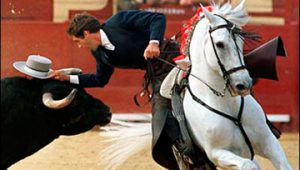Hermoso de Mendoza Shows Us How It’s Done
By Mark Schwarz

“Suerte” (luck in Spanish) is a word thrown around Plazas de Toros worldwide the way lobbyists throw around money in election years. “Suerte” for good bulls, “suerte” for good weather, “suerte” for abundant sun and no wind, good friends, good food, wine, women, suerte, suerte, suerte. The inference, I suppose, is that “suerte”, however you conceive of it, is capricious but essential, not to be trusted and obtained by whatever means necessary.
Luck has also been defined—in decidedly less poetic terms—as that point where “preparation and opportunity meet”, a definition which occurred to me after viewing the near perfection of Spanish master Pablo Hermoso de Mendoza (and to a lesser, but no less valuable, extent, crystallizing promise Juan Pablo Sanchez) in the second corrida of the unusual year in Tijuana’s Plaza Monumental de Playas.
I did wish “suerte” to Mendoza just before he was engulfed by a significant portion of the outstanding crowd (solid estimates of over 12,000) but failed to reach Sanchez, who battles on through an abrupt and murkily suspect collision with the taurine king-makers in Mexico and Spain. As we watched, it appeared that both men were beyond either romantic notions of destiny or deterministic measures of preparation; such is their capacity, inspiration, and ambition.
Mendoza has ruled the world of rejoneo (bullfighting from horseback) for the last 15 years; he has changed every metric and standard that ruled the once admittedly fuzzy profession, and has recast it in his own image, not unlike the great Juan Belmonte, who revolutionized toreo a pie (bullfighting on foot) a century ago. His horses are his co-actors, and he, and they, form a new being (he is often referred to in the Spanish press as the “centaur”) where there are not two wills, human and animal, but one, rejoneo. It doesn’t stop there; his capacity to dominate the bulls they face is the equal of his ability to maneuver his equine alter-egos.
I am not as studied in the art of Marialva as I am regular toreo, but with such demonstrations the excellence is almost self evident; granted, his first bull, “Playero” of the Los Encinos ranch, tirelessly pursued the horses and offered Mendoza a great opportunity but also the great challenge of pulling everything out of “Playero” that he could give—and he did.
Exposing his cuadra of beautiful horses to the maddening graze of “Playero’s” searching horns, Mendoza offered a doctoral dissertation on the art, which, curiously, lacked only the sometimes excessive histrionics that occasionally mar his finest work. There was not a wasted movement or moment; efficiency, pace. The final rejon de muerte was not as true as Mendoza hoped on the first attempt, but the second felled the outstanding animal almost without delay.
Amazingly, Mendoza’s prize was a miserly ear from ring judge Galvan, and the outstanding “Playero” received not even a slow drag out let alone the posthumous vuelta that his classy and determined bravery deserved…
Although his second bull did not begin to approach the quality of “Playero”, it mattered little; Mendoza needs little in the way of cooperation from his bovine opposites; Mendoza compensated for “Nono’s” lack of celo with more than adequate determination to cut the two ears that he believed should have been awarded from his first.
Again risking the impressive physiques of his gorgeous horses, Mendoza demonstrated why all future discussion of the art of rejoneo should, like modern references to time, be defined as rejoneo AEM or PEM, which would be Before the Mendoza Era or After the Mendoza Era.
Juan Pablo Sanchez is another torero for whom “luck” seems an antiquated term.
Like the great charro/matador Mariano Ramos before him, Sanchez’ control of the technique of toreo, his mando(control over the bull) is so integral to his practice and philosophy of toreo that it frequently goes unnoticed by the neophyte or unappreciated, even by aficionados who should know better. He is seldom in danger and never out of place; every movement has a purpose, every pass is nearly technically perfect.
One gets the sense that no bull can put him on the defensive, that no bull is too great a test. This, of course, can cut both ways.
His modest personality doesn’t typically lend itself to indulgent showboating and his performances sometimes seem a little cold and intellectual, rather like a mathematician solving a particularly (t)horny problem.
Neither of his bulls this day had enough gas in the tank to allow for complete faenas, but what work Sanchez was able to accomplish was replete with the sense of timing and control for which he is famous. He cut a well deserved ear from his second bull.
Federico Pizarro, in his 20 year career, has experienced a resurgence of personal illusion and a reencounter with a public that probably under-appreciated him initially. His inclusion as the senior member of many cartels has added a certain solemnity and nostalgia to the afternoons, though verifiable successes have been few. He cut a generous ear from his second bull, and his afternoon was one of isolated moments of quality and similar moments of “querer pero no poder”—”wanting but not being able”.